Assessment of the Impact of Applying a Non-Factory Dual-Fuel (Diesel/Natural Gas) Installation on the Traction Properties and Emissions of Selected Exhaust Components of a Road Semi-Trailer Truck Unit
Abstract
:1. Introduction
2. Purpose, Object and Research Plan
- Determination of the external characteristics of the D13C460 engine when fueled by the basic fuel, which was diesel;
- Determination of the external characteristics of the D13C460 engine with a diesel/CNG supply system installed and optimized on a dynamometric test bench during dual fuel operation;
- An assessment of the impact of the dual-fuel diesel/CNG supply of the D13C460 engine on the tractive effort curves of a semi-trailer truck and semi-trailer combination with a total weight of 40 tons;
- An assessment of the impact of the dual fuel diesel/CNG supply on the emission of the toxic exhaust gas components during the research test in accordance with the requirements of the UNECE Regulation No. 49.
2.1. Determination of the External Characteristics of the Engine
2.2. Traction Characteristics—Forces and Vehicle Performance
2.3. Selection of Data for Calculations
2.4. Results of Tractive Effort Calculations
2.5. Exhaust Emission Tests in Accordance with the Requirements of the UNECE Regulation No. 49
3. Conclusions
- Factory data (published by the manufacturer) concerning the maximum value of torque and power, as well as the course of their changes in the area of the tested engine RPMs, differ significantly from those determined in the measurements on the dynamometer, both with diesel fuel and Diesel/CNG. This affected the traction calculations, in which the semi-trailer truck (towing semi-trailer) with an engine with factory parameters always had the best results. For this reason, they were treated as achievable values; however, the comparisons themselves were made only for the results of laboratory measurements.
- Changing the supply fuel (from Diesel fuel to Diesel/CNG) does not significantly reduce the traction characteristics of the vehicle, and the changes are so small that the driver should not notice the differences indicated in the calculations (very similar acceleration values, distance and time traveled, hill-climbing ability, use of the same gear in the same state of movement, etc.).
- The engine power values determined in the laboratory tests show differences in relation to the factory characteristics, which is the result of the natural processes of engine wear. As a result, irrespective of the fuel used, the power field losses occurred, which are greater when supplied with Diesel/CNG. This can lead to a slight increase in fuel consumption when driving with the use of higher engine speeds—above 1500 rpm for diesel fueling and above 1400 rpm for Diesel/CNG.
- Similar fluctuations occur with torque. The biggest disadvantages for Diesel/CNG supply, compared to Diesel fuel only, seems the lower torque values, close to 1500 rpm. As calculated, it may result in a temporary reduction of the achieved acceleration value up to 10%.
- A decrease in the CO2 content was noticed during with the Diesel/CNG mixture, which is related to the change of the elemental hydrogen and carbon particles ratio in the outgoing exhaust gas. It is a favorable phenomenon in terms of the emission of toxic and greenhouse gases. The changes in the CO2 content are proportional to the changes in the Diesel/CNG replacement factor.
- There was a dozen or so percent increase in the content of NO. It involves changing the combustion process to similar to combustion in typical spark ignition engines. The introduction of CNG into the intake manifold reduces the excess air ratio and increases the combustion temperature of the air-fuel mixture. Increasing the combustion temperature results in an increase in NO2 content, which affects the total NOx emissions. The vehicle’s engine is equipped originally with an SCR system that should reduce NOx emissions to the required level.
- A several hundred-fold increase in the methane content in the exhaust gas was noticed. This is related to the contraction of the intake and exhaust systems—air flushing of the combustion chamber. This phenomenon may also cause an increase in CO emissions during homologation tests and, as a result, exceed the limits resulting from the requirements of EURO emissions standards. This conclusion is confirmed by the several dozen-fold increase in the content of CO in the exhaust gas. This results from the changes in the organization of the combustion process (similar situation to the NOX concentration). By introducing CNG into the intake manifold, the fuel is mixed with air in advance, resulting in an almost homogeneous mixture which is then supplied to the cylinder. After compression, Diesel fuel is injected into this air-CNG mixture in liquid phase. This causes local oxygen deficiencies—which favors incomplete combustion and the formation of carbon monoxide as well as an increase in smoke occurrence during Diesel/CNG supply in the range of 50–120%, depending on the operating conditions. This phenomenon is very unfavorable from the point of view of environmental protection due to the increased emission of solid particles to the atmosphere.
- There may be several reasons for the increased opacity of exhaust gases:
- o
- Reduction of the excess air factor due to the supply of CNG fuel in gaseous form,
- o
- o
- Local oxygen deficiencies resulting from the co-combustion of CNG and Diesel fuel, which leads to a local reduction of the excess air ratio, especially in the area of diesel fuel combustion.
Author Contributions
Funding
Institutional Review Board Statement
Informed Consent Statement
Data Availability Statement
Conflicts of Interest
Abbreviations
| a | longitudinal distance from center of gravity to front axle |
| av | vehicle acceleration |
| Ax | frontal area of the vehicle body |
| b | longitudinal distance from center of gravity to rear axle |
| bw | front track width |
| CNG | Compressed Natural Gas |
| CO2 | Carbon Dioxide |
| CO | Carbon Oxide |
| CD | aerodynamic drag coefficient |
| D | performance factor |
| dv/dt | vehicle acceleration |
| FD | aerodynamic drag force |
| FdH | force acting in drawbar |
| Fg | grading resistance |
| Fi | inertia force |
| FP | pulling force |
| Fr | rolling resistance |
| fr | rolling resistance coefficient |
| FT | traction force |
| FRT | total resistance force |
| g | standard gravity |
| H | vehicle height |
| hS | height of the center of mass |
| hD | height of the center of wind pressure |
| hH | height of towing hitch |
| igb | gear box ratio |
| Ik | moment of interia of k-th rotating element reduced to the driving wheel axis |
| idl | driveline ratio |
| L | wheelbase |
| LNG | Liquid Natural Gas |
| m | vehicle mass |
| NOx | Nitrogen Oxides |
| NO2 | Nitrogen Dioxide |
| Pe | engine power |
| Pt | traction power |
| ns | engine speed (rpm) |
| rD | dynamic rolling radius |
| rK | kinematic rolling radius |
| S | center of mass |
| Sa | acceleration distance |
| SCR | selective catalytic reduction |
| ta | acceleration time |
| Te | engine torque |
| Ti | inertia torque |
| v | vehicle speed in m/s |
| vr | relative speed of vehicle and wind velocity component in the vehicle moving direction |
| WT | trailer weight |
| WV | vehicle weight |
| Z1, Z2 | normal force under front and rear wheels, respectively |
| α | road inclination angle |
| αH | tilt angle of drawbar |
| γ | fill factor of the frontal area of the vehicle body |
| δ | rotating mass factor |
| ηdl | driveline efficiency |
| ρ | density of the ambient air |
| Ψ | road resistance |
| ωw | angular velocity of the driving wheel |
References
- Marseglia, G.; Vasquez-Pena, B.F.; Medaglia, C.M.; Chacartegui, R. Alternative Fuels for Combined Cycle Power Plants: An Analysis of Options for a Location in India. Sustainability 2020, 12, 3330. [Google Scholar] [CrossRef] [Green Version]
- Marseglia, G.; Rivieccio, E.; Medaglia, C.M. The dynamic role of Italian energy strategies in the worldwide scenario. Kybernetes 2019, 48, 636–649. [Google Scholar] [CrossRef]
- Proost, S.; Van Dender, K. Energy and environment challenges in the transport sector. Econ. Transp. 2012, 1, 77–87. [Google Scholar] [CrossRef]
- Pietrzak, K.; Pietrzak, O. Environmental effects of electromobility in a sustainable urban public transport. Sustainability 2020, 12, 1052. [Google Scholar] [CrossRef] [Green Version]
- Vohra, K.; Vodonos, A.; Schwartz, J.; Marais, E.A.; Sulprizio, M.P.; Mickley, L.J. Global mortality from outdoor fine particle pollution generated by fossil fuel combustion: Results from GEOS-Chem. Environ. Res. 2021, 195, 110754. [Google Scholar] [CrossRef]
- Dziubak, T. Experimental Studies of Dust Suction Irregularity from Multi-Cyclone Dust Collector of Two-Stage Air Filter. Energies 2021, 14, 3577. [Google Scholar] [CrossRef]
- Dziubak, T. Performance characteristics of air intake pleated panel filters for internal combustion engines in a two-stage configuration. Aerosol Sci. Technol. 2018, 52, 1293–1307. [Google Scholar] [CrossRef]
- Wołek, M.; Wolański, M.; Bartłomiejczyk, M.; Wyszomirski, O.; Grzelec, K.; Hebel, K. Ensuring sustainable development of urban public transport: A case study of the trolleybus system in Gdynia and Sopot (Poland). J. Clean. Prod. 2021, 279, 123807. [Google Scholar] [CrossRef]
- Grijalva, E.R.; López Martínez, J.M. Analysis of the Reduction of CO2 Emissions in Urban Environments by Replacing Conventional City Buses by Electric Bus Fleets: Spain Case Study. Energies 2019, 12, 525. [Google Scholar] [CrossRef] [Green Version]
- Junga, R.; Pospolita, J.; Niemiec, P.; Dudek, M.; Szleper, R. Improvement of coal boiler’s efficiency after application of liquid fuel additive. Appl. Therm. Eng. 2020, 179, 115663. [Google Scholar] [CrossRef]
- Feiock, R.C.; Stream, C. Environmental protection versus economic development: A false trade-off? Public Adm. Rev. 2001, 61, 313–321. [Google Scholar] [CrossRef]
- Wallander, J.L.; Schmitt, M.; Koot, H.M. Quality of life measurement in children and adolescents: Issues, instruments, and applications. J. Clin. Psychol. 2001, 57, 571–585. [Google Scholar] [CrossRef] [PubMed]
- European Mobility Week. Available online: https://ec.europa.eu/inea/en/news-events/events/european-mobility-week-2017 (accessed on 3 April 2021).
- Parzentny, H.R.; Róg, L. Distribution and Mode of Occurrence of Co, Ni, Cu, Zn, As, Ag, Cd, Sb, Pb in the Feed Coal, Fly Ash, Slag, in the Topsoil and in the Roots of Trees and Undergrowth Downwind of Three Power Stations in Poland. Minerals 2021, 11, 133. [Google Scholar] [CrossRef]
- Frankowski, J. Attention: Smog alert! Citizen engagement for clean air and its consequences for fuel poverty in Poland. Energy Build. 2020, 207, 109525. [Google Scholar] [CrossRef]
- Czyżewski, B.; Trojanek, R.; Dzikuć, M.; Czyżewski, A. Cost-effectiveness of the common agricultural policy and environmental policy in country districts: Spatial spillovers of pollution, bio-uniformity and green schemes in Poland. Sci. Total Environ. 2020, 726, 138254. [Google Scholar] [CrossRef] [PubMed]
- Adrian, Ł.; Piersa, P.; Szufa, S.; Romanowska-Duda, Z.; Grzesik, M.; Cebula, A.; Kowalczyk, S.; Ratajczyk-Szufa, J. Experimental research and thermographic analysis of heat transfer processes in a heat pipe heat exchanger utilizing as a working fluid R134A. In Renewable 17. Energy Sources: Engineering, Technology, Innovation; Springer: Berlin/Heidelberg, Germany, 2018; pp. 413–421. [Google Scholar]
- Emissions of the Main Air Pollutants in Europe. Available online: https://www.eea.europa.eu/data-and-maps/indicators/main-anthropogenic-air-pollutant-emissions-1/assessment (accessed on 3 November 2021).
- Eurostat (European Commission). Energy, Transport and Environment Statistics; Collection: Statistical Books; Publications Office of the European Union: Luxembourg, 2020. [Google Scholar] [CrossRef]
- 40ton.net. Available online: https://40ton.net/volvo-fh-electric-trafilo-do-oferty-duza-kabina-300-km-zasiegu-664-km-mocy-i-zaporowa-cena/ (accessed on 15 October 2021).
- Jamrozik, A.; Tutak, W.; Grab-Rogaliński, K. An Experimental Study on the Performance and Emission of the diesel/CNG Dual-Fuel Combustion Mode in a Stationary CI Engine. Energies 2019, 12, 3857. [Google Scholar] [CrossRef] [Green Version]
- Warguła, L.; Kukla, M.; Lijewski, P.; Dobrzyński, M.; Markiewicz, F. Impact of Compressed Natural Gas (CNG) Fuel Systems in Small Engine Wood Chippers on Exhaust Emissions and Fuel Consumption. Energies 2020, 13, 6709. [Google Scholar] [CrossRef]
- Lejda, K.; Jaworski, A.; Mądziel, M.; Balawender, K.; Ustrzycki, K.; Savostin-Kosiak, D. Assessment of Petrol and Natural Gas Vehicle Carbon Oxides Emissions in the Laboratory and On-Road Tests. Energies 2021, 14, 1631. [Google Scholar] [CrossRef]
- Hanson, R.; Curran, S.; Wagner, R.; Kokjohn, S.; Splitter, D.; Reitz, R. Piston Bowl Optimization for RCCI Combustion in a Light-Duty Multi-Cylinder Engine. SAE Int. J. Engines 2012, 5, 286–299. [Google Scholar] [CrossRef]
- Heywood, J.B. Internal Combustion Engine Fundamentals; McGraw-Hill Education: New York, NY, USA, 2018; ISBN 9781260116106. [Google Scholar]
- Prochowski, L. Pojazdy Samochodowe. Mechanika Ruchu; Wydawnictwo Komunikacji i Łączności: Warszawa, Poland, 2016; ISBN 978-83-206-1957-7. pp. 69–96. [Google Scholar]
- Peng, J.; Wang, T.; Yang, T.; Sun, X.; Li, G. Research on the Aerodynamic Characteristics of Tractor-Trailers with a Parametric Cab Design. Appl. Sci. 2018, 8, 791. [Google Scholar] [CrossRef] [Green Version]
- Arczyński, S. Mechanika Ruchu Samochodu; Wydawnictwa Naukowo-Techniczne: Warszawa, Poland, 1994; pp. 92–104. ISBN 83-204-1488-1. [Google Scholar]
- Gillespie, T.D. Fundamentals of Vehicle Dynamics; Society of Automotive Engineers: Warrendale, PA, USA, 1992; pp. 1–43. [Google Scholar]
- Gao, Y. Vehicle Dynamics and Performance. In Encyclopedia of Sustainability Science and Technology; Meyers, R.A., Ed.; Springer: New York, NY, USA, 2012. [Google Scholar] [CrossRef]
- Lanzendoerfer, J.; Szczepaniak, C. Teoria Ruchu Samochodu; WKŁ: Warszawa, Poland, 1980; pp. 120–132. [Google Scholar]
- Mitschke, M. Teoria Samochodu. Dynamika Samochodu. Napęd i Hamowanie. Tom 1; WKŁ: Warszawa, Poland, 1987; pp. 86–128. [Google Scholar]
- Dz.U.2015 poz. 2022-Obwieszczenie Ministra Infrastruktury i Budownictwa z Dnia 27 Października 2016 r. w Sprawie Ogłoszenia Jednolitego Tekstu Rozporządzenia Ministra Infrastruktury w Sprawie Warunków Technicznych Pojazdów Oraz Zakresu Ich Niezbędnego Wyposażenia; Dziennik Ustaw Rzeczypospolitej Polskiej, Prezes Rady Ministrów: Warszawa, Poland, 2003. Available online: http://isap.sejm.gov.pl/isap.nsf/download.xsp/WDU20030320262/O/D20030262.pdf (accessed on 12 July 2021).
- Manufacturer’s Materials, Volvo, Gear Actuator, Design, Function, Repair, Version 2, 2nd ed.; WABCO: Bern, Switzerland, 2020; Available online: https://www.wabco-customercentre.com/catalog/docs/8150202273.pdf (accessed on 15 July 2021).
- Volvotrucks.pl. Available online: https://www.volvotrucks.pl/content/dam/volvo/volvo-trucks/markets/poland/Kamil/Volvo-Serii-FH_Dane-Techniczne_PL.pdf (accessed on 15 July 2021).
- Semperit.com. Available online: https://blobs.semperit.com/www8/servlet/blob/1203744/c865b910ae14026eeff5a77b81000454/semperit-technical-data-book-data.pdf (accessed on 12 July 2021).
- Owczarzak, W.; Sommer, S. The influence of inflation pressure and ambient temperature on the value of the truck tires rolling resistance. Autobusy 2019, 12, 77–82. [Google Scholar] [CrossRef]
- Guo, M.; Li, X.; Ran, M.; Zhou, X.; Yan, Y. Analysis of Contact Stresses and Rolling Resistance of Truck-Bus Tyres under Different Working Conditions. Sustainability 2020, 12, 10603. [Google Scholar] [CrossRef]
- Wilcox, D. Resistance movement. Transp. Eng. 2006, 8, 20–23. [Google Scholar]
- Manufacturer’s Materials, Naczepa Kurtynowa Kögel; TYP: S 24 P 90/1.100. Available online: http://tmc-transport.pl/art/files/8, (accessed on 15 July 2021).
- Hucho, W.H. Teoria Samochodu. Aerodynamika Samochodu. Od Mechaniki Przepływu do Budowy Pojazdu; WKŁ: Warszawa, Poland, 1987; pp. 271–302. [Google Scholar]
- Schuetz, T.C. Aerodynamics of Road Vehicles. In Commercial Vehicles, 5th ed.; Kopp, S., Frank, T., Eds.; SAE International: Warrendale, PA, USA, 2015; Chapter 10. [Google Scholar]
- CITT PL. Aerodynamika Pojazdów o Urwistym Kształcie Nadwozia. Available online: http://lctt.pollub.pl (accessed on 12 July 2021).
- Popielawski, S.; Orzech, P.; Wawrzyńska, E.; Gąsior, D.; Sarna, O.; Szmidt, G.; Zientek, I.; Cieśla, M. Wpływ lekkich konstrukcji naczep siodłowych na efektywność procesów logistycznych. Zesz. Stud. Nasze Studiaquot 2019, 9, 78–88. Available online: https://czasopisma.bg.ug.edu.pl/index.php/naszestudia/article/view/3381 (accessed on 6 August 2021).
- Dz.U.2016 poz. 124—Rozporządzenie Ministra Transportu i Gospodarki Morskiej z Dnia 2 Marca 1999 r. w Sprawie Warunków Technicznych, Jakim Powinny Odpowiadać Drogi Publiczne i Ich Usytuowanie; Dziennik Ustaw Rzeczypospolitej Polskiej, Prezes Rady Ministrów: Warszawa, Poland, 2016. Available online: http://isap.sejm.gov.pl/isap.nsf/download.xsp/WDU20160000124/O/D20160124.pdf (accessed on 13 September 2021).
- COMMISSION REGULATION (EU) No 1230/2012 of 12 December 2012 Implementing Regulation (EC) No 661/2009 of the European Parliament and of the Council with Regard to Type-Approval Requirements for Masses and Dimensions of Motor Vehicles and Their Trailers and Amending Directive 2007/46/EC of the European Parliament and of the Council. Available online: https://eur-lex.europa.eu/legal-content/EN/TXT/?uri=CELEX%3A32012R1230 (accessed on 13 September 2021).
- Europa-ciezarowki.pl. Available online: https://www.europa-ciezarowki.pl/vi/volvo~b774 (accessed on 15 July 2021).
- Yavuz, H.; Bayrakçeken, H.; Aysal, F.E. Comparison of Ideal Traction Hyperbola Curves with Matlab-Simulink in Vehicles. Int. J. Automot. Sci. Technol. 2020, 4, 244–247. [Google Scholar] [CrossRef]
- Available online: https://eur-lex.europa.eu/LexUriServ/LexUriServ.do?uri=OJ:L:2011:180:0053:0069:PL:PDF (accessed on 10 April 2021).
- Karczewski, M.; Chojnowski, J.; Szamrej, G. A Review of Low-CO2 Emission Fuels for a Dual-Fuel RCCI Engine. Energies 2021, 14, 5067. [Google Scholar] [CrossRef]
- Karczewski, M.; Szczęch, L. Influence of the F-34 unified battlefield fuel with bio components on usable parameters of the IC engine. Eksploat. Niezawodn.—Maint. Reliab. 2016, 18, 358–366. [Google Scholar] [CrossRef]
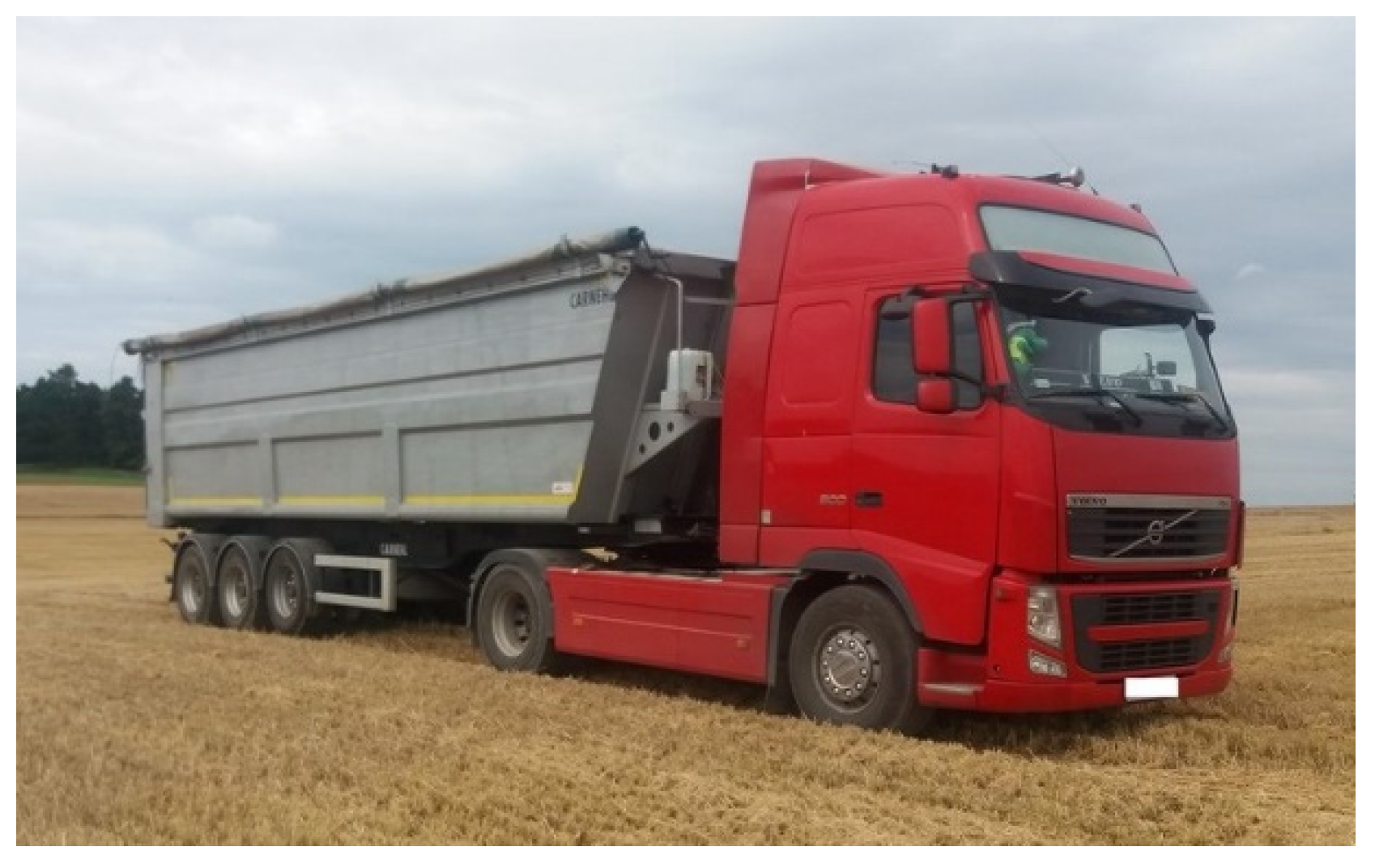

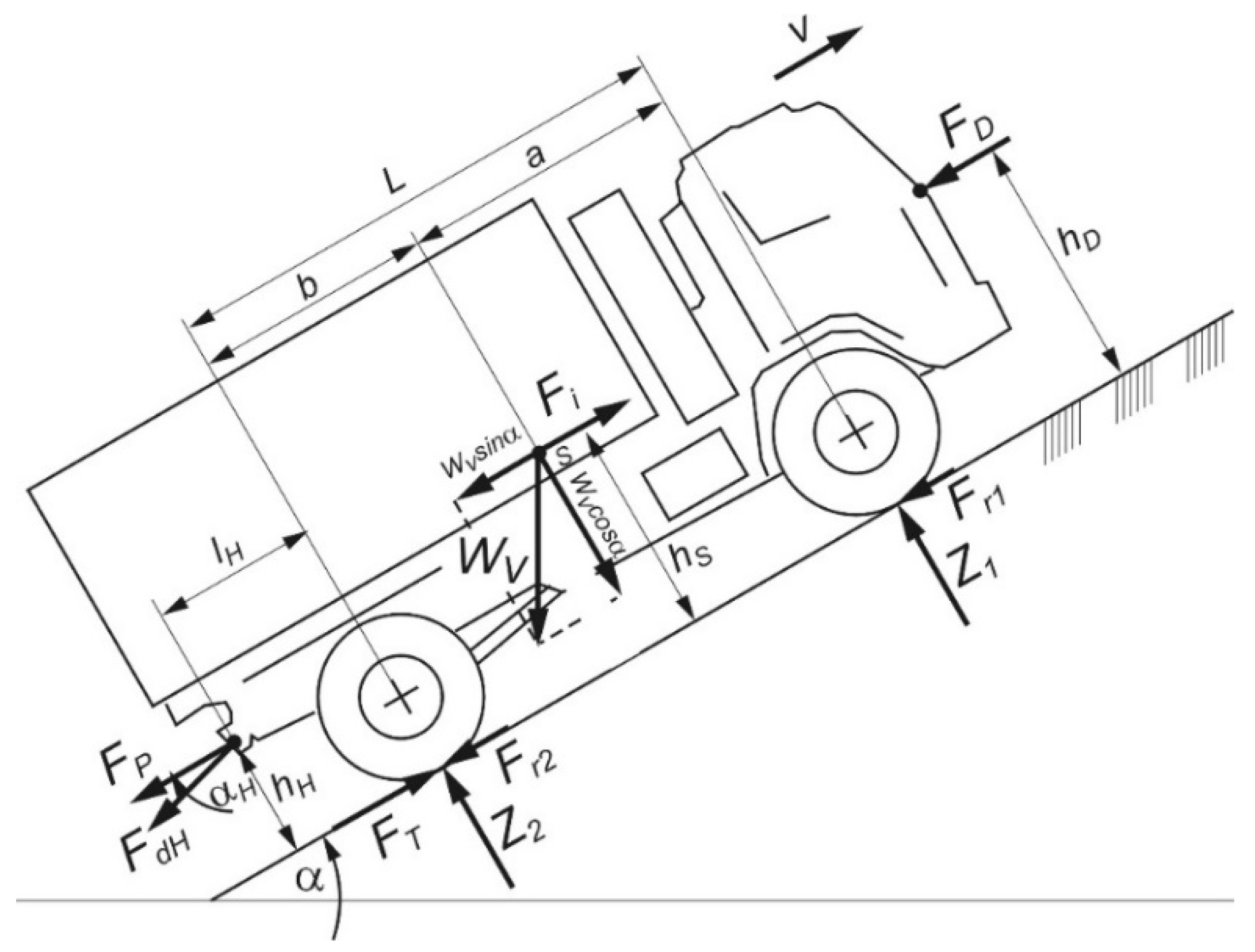
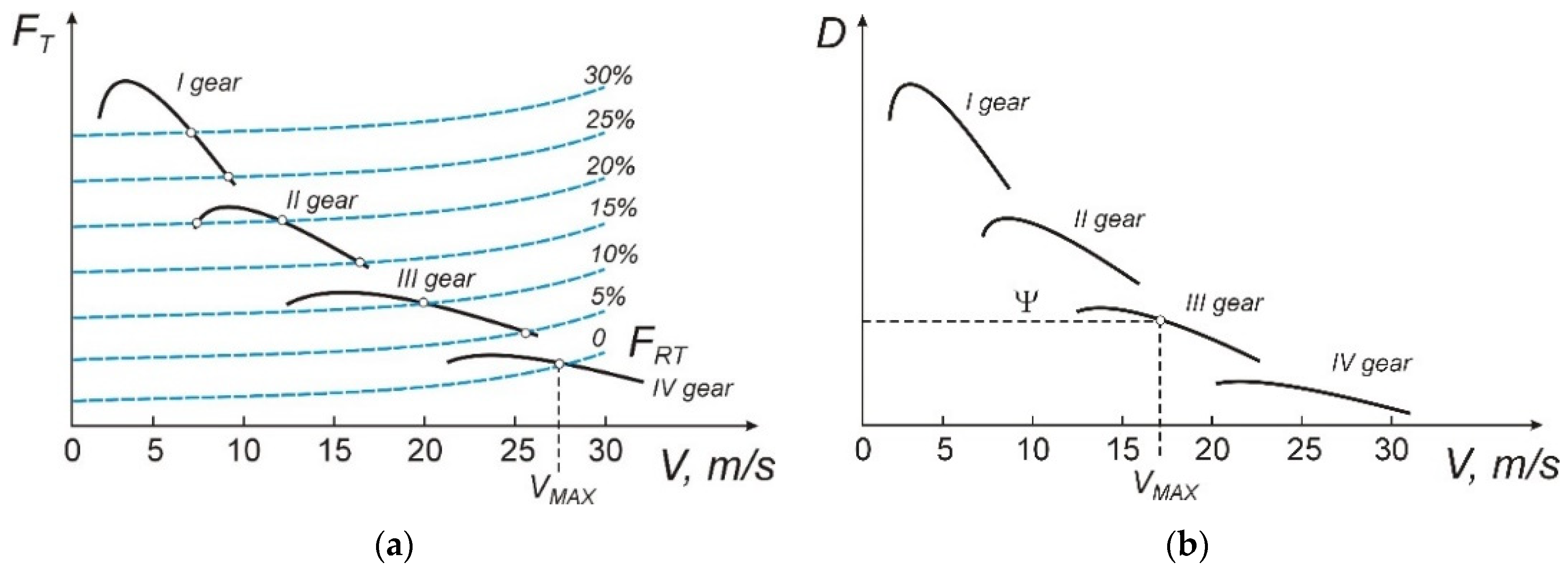
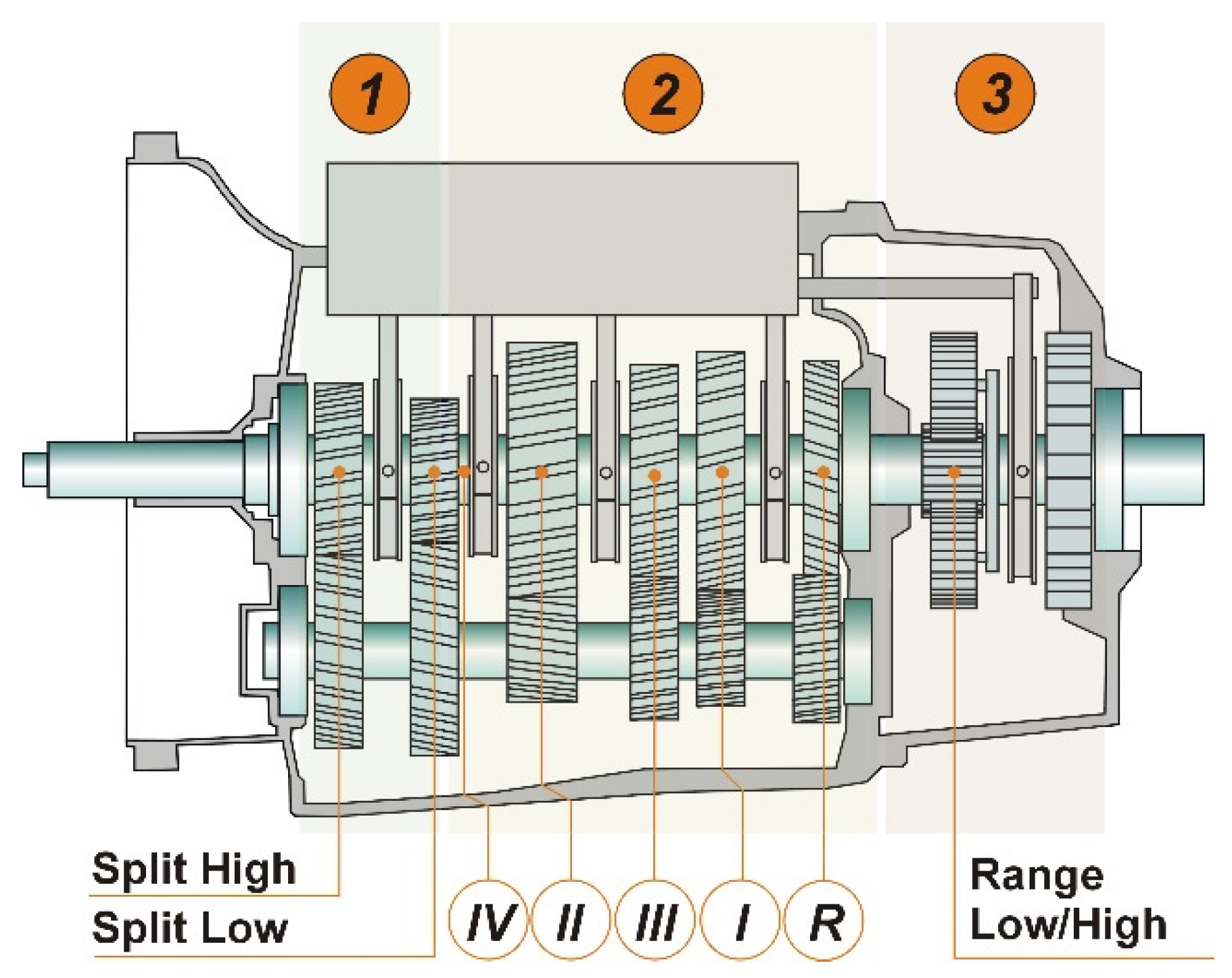
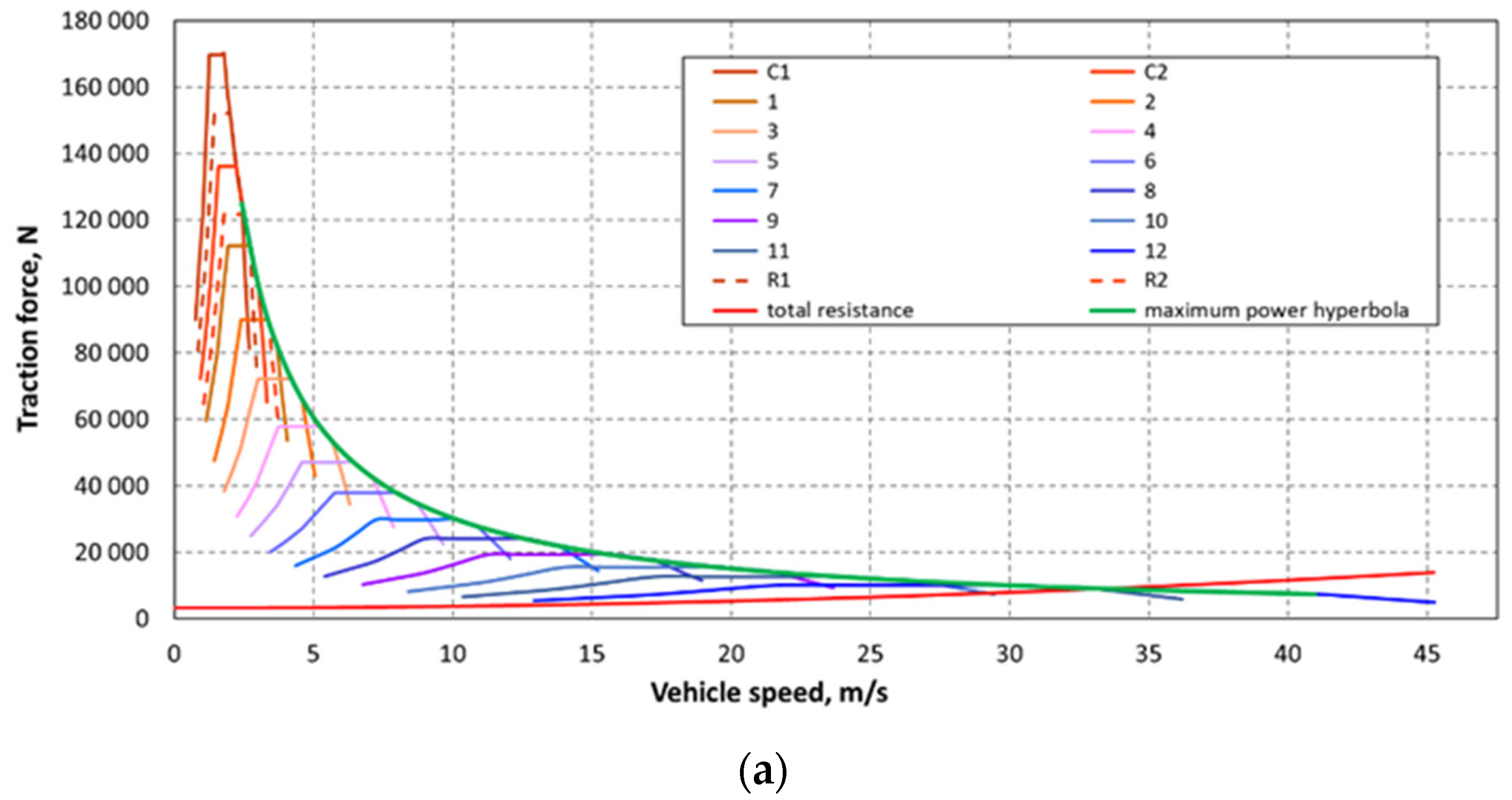
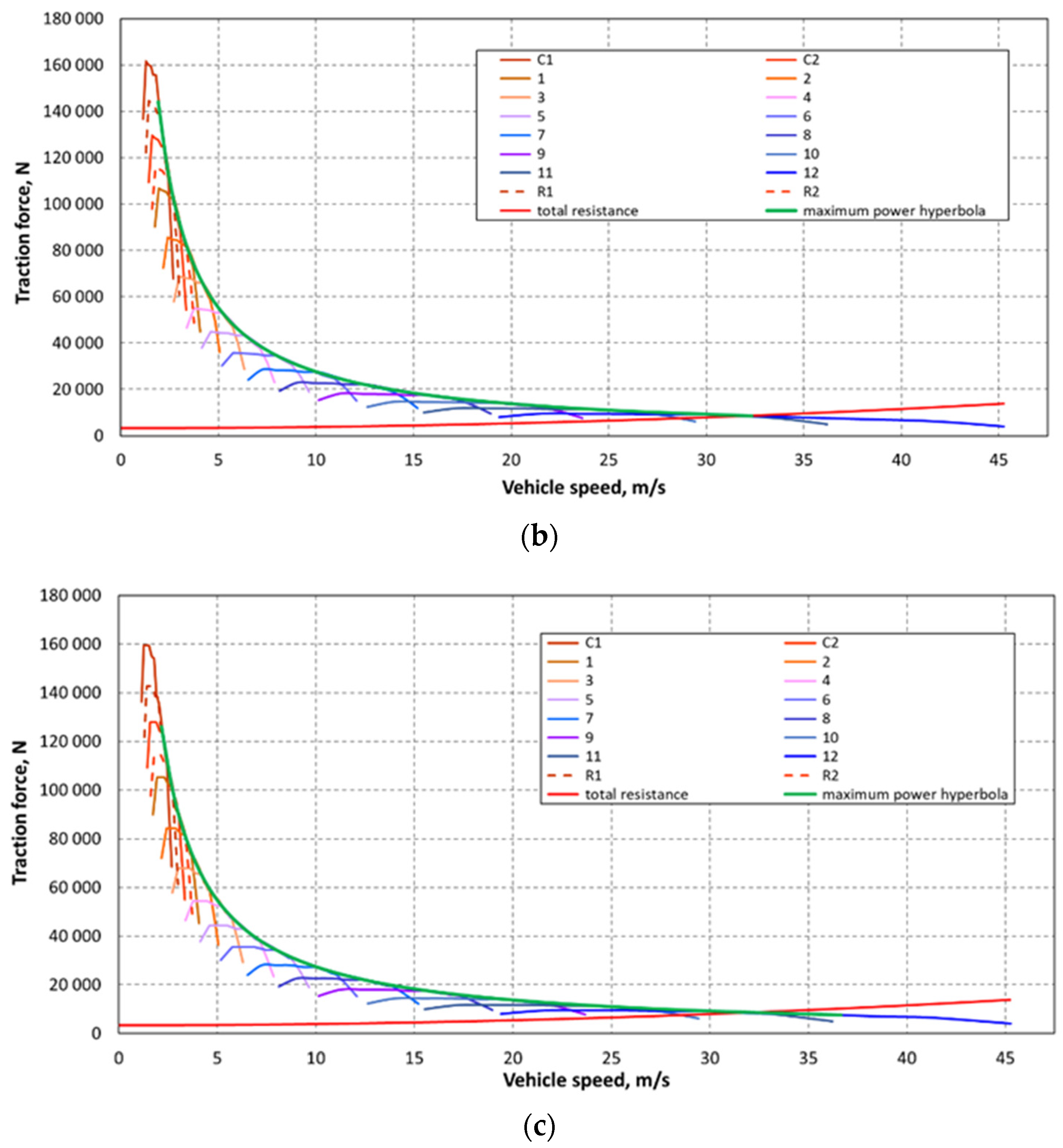



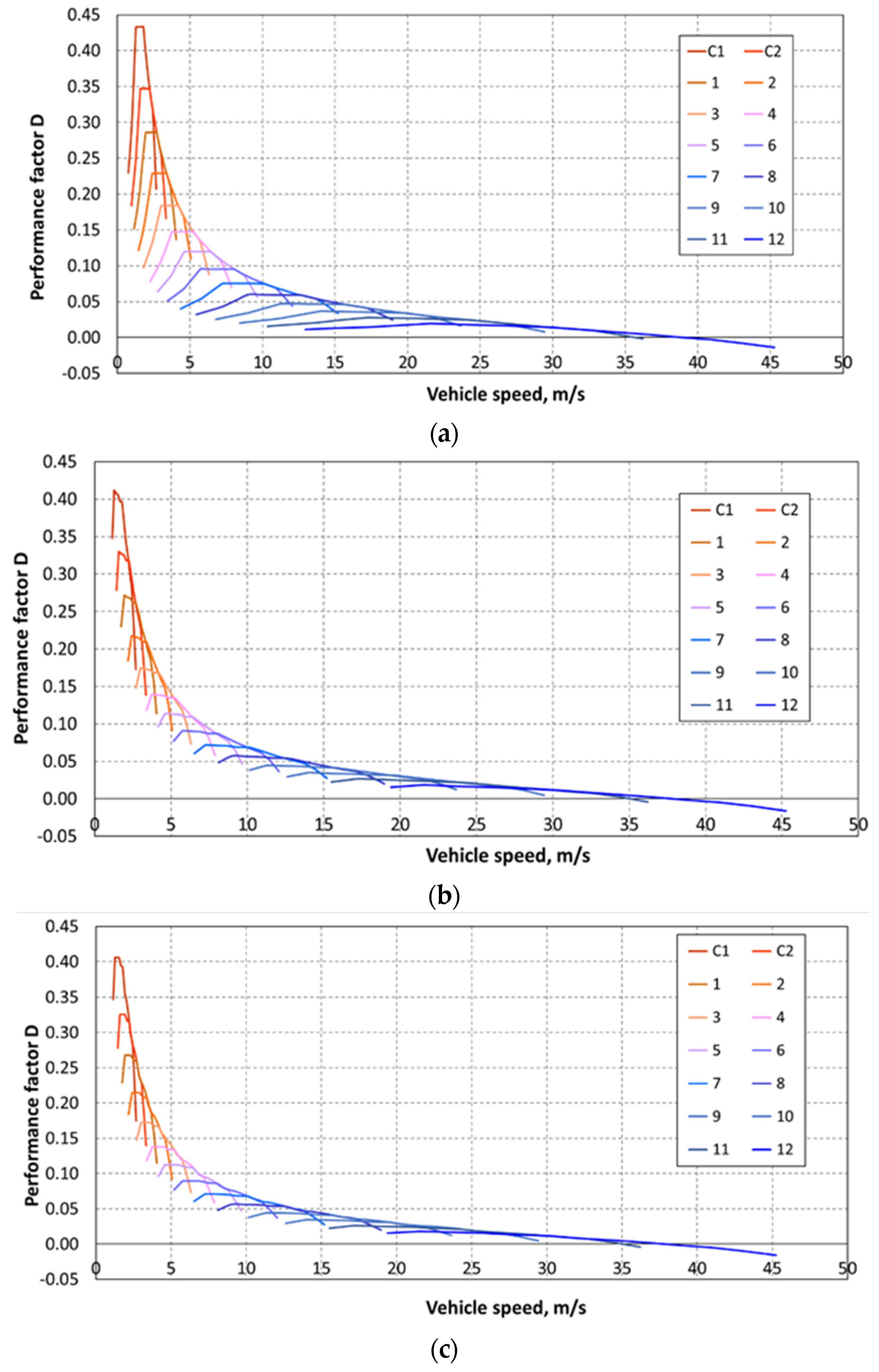



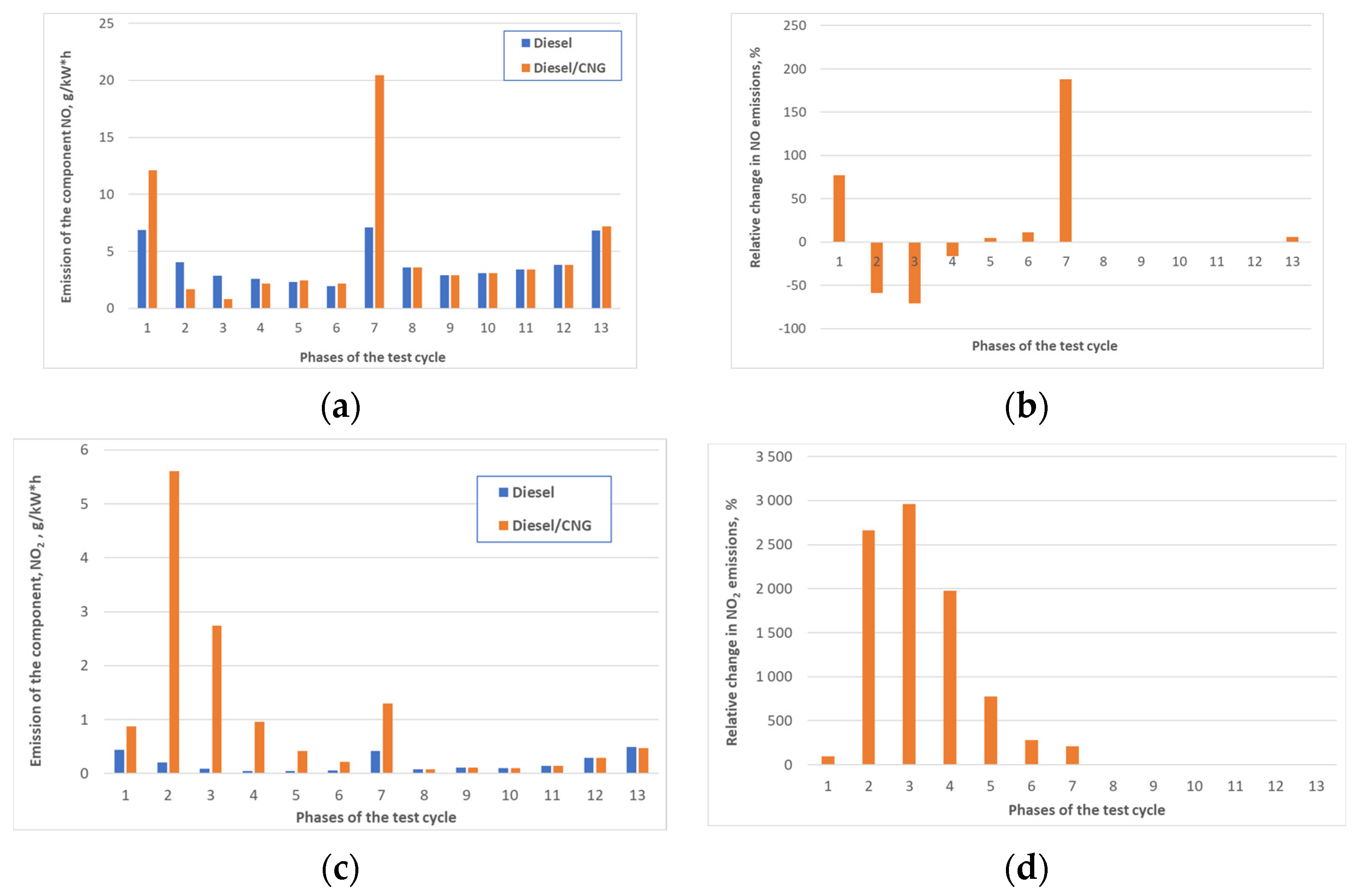
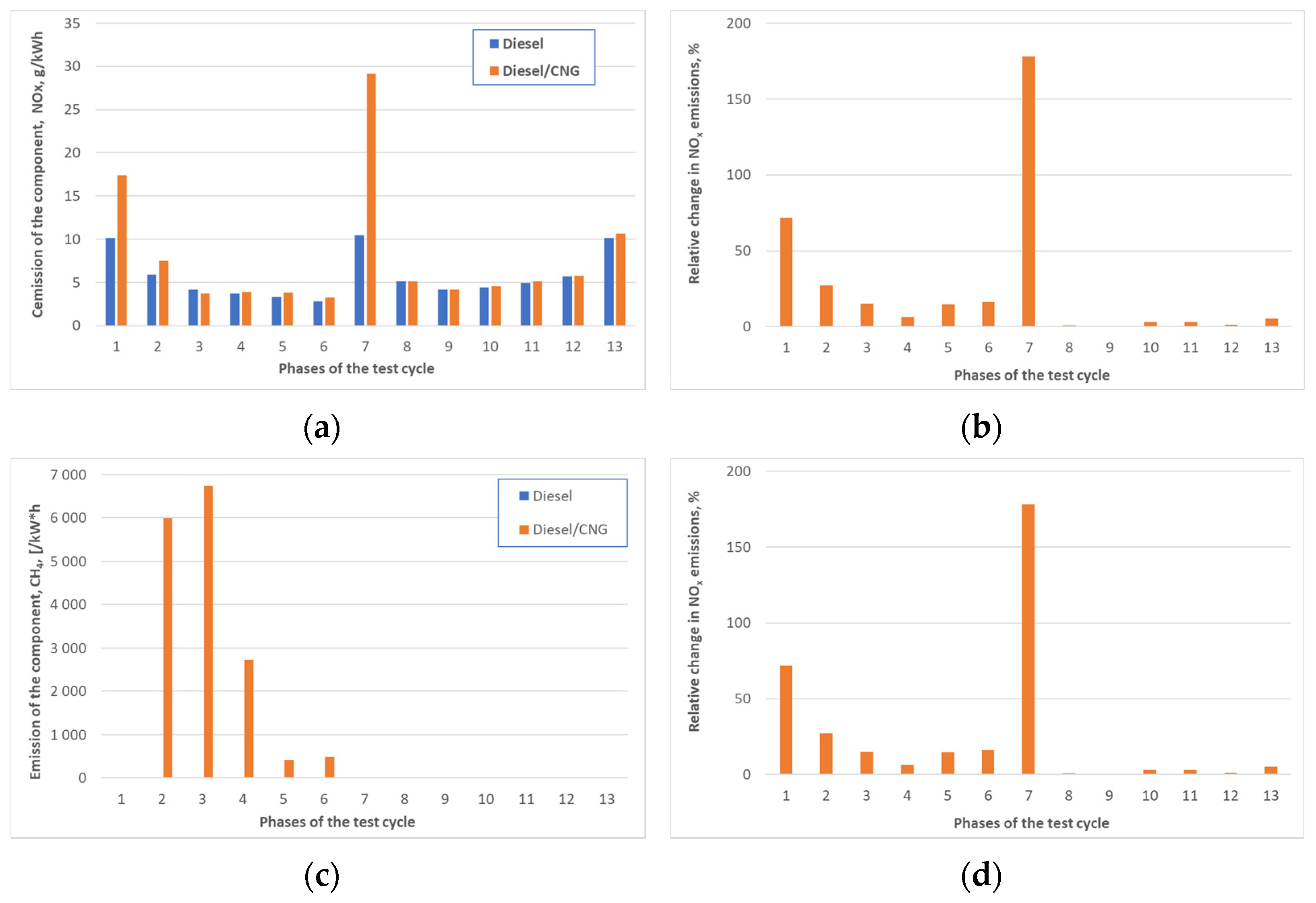


| No. | Name of Device/Measured Quantity | Type | Range | Accuracy |
|---|---|---|---|---|
| 1. |
Water dynamometer
| Zöllner PS1-3812/AE | Mo = (0 ÷ 700) N∙m, n = (0 ÷ 4000) rpm | ±1 N∙m, ±1 rpm, |
| 2. | Fuel weight-meter (diesel) | AVL 733S Fuel Balance | (0 ÷ 200) kg/h | ±0.005 kg/h |
| 3. | Fuel weight-meter (CNG) | SwirlMaster FSS450 Intelligent Swirl Flowmeter | 1.2–104.6 kg/h | ±0.6% measured quantity |
| 4. | Exhaust analyzer—measuring of toxic elements Concentration in exhaust gases
| AVL CEBII | HC (1.0 ÷ 2200) ppm, NOx (1.0 ÷ 6000) ppm | ±0.1% measured quantity |
| 5. | Exhaust analyzer—measuring of toxic elements Concentration in exhaust gases
| atmosFIR, emissions monitoring FTIR systems | CO2 (0.01 ÷ 23)% CO (1.0 ÷ 11,000) ppm, NOx (1.0 ÷ 6000) ppm NO2 (1.0 ÷ 6000) O2 (0.1 ÷ 21)% | ±0.1% measured quantity |
| 6. | Smoke concentration—extinction coefficient of light radiation—k. | AVL Opacimeter 4390 | (0.001 ÷ 10.0) m−1 | ±0.002 m−1 |
| 7. | Thermocouple—measuring of exhaust temperature—T | NiCr—NiAl (K) | (−50 ÷ 1100) °C | ±1 °C |
| 8 | Mass air consumption | SensyMaster FMT430 Thermal Mass Flowmeter | 120 ÷ 7000 kg/h | ±1.2 kg/h |
| Engine Speed | Factory Data | Diesel | Diesel/CNG | |||
|---|---|---|---|---|---|---|
| RPM | N∙m | kW | N∙m | kW | N∙m | kW |
| 600 | 1220 | 76.6 | - | - | - | - |
| 700 | 1430 | 104.8 | - | - | - | - |
| 800 | 1650 | 138.2 | - | - | - | - |
| 900 | 1975 | 186.1 | 1850 | 152.9 | 1845 | 152.4 |
| 1000 | 2300 | 240.8 | 2190 | 201.5 | 2160 | 198.4 |
| 1100 | 2300 | 264.9 | 2170 | 220.8 | 2160 | 219.6 |
| 1200 | 2300 | 289.0 | 2160 | 240.6 | 2160 | 240.0 |
| 1300 | 2300 | 313.1 | 2110 | 254.7 | 2100 | 253.3 |
| 1400 | 2305 | 337.9 | 2110 | 274.5 | 2090 | 271.9 |
| 1500 | 2151 | 337.9 | 1980 | 275.9 | 1890 | 263.4 |
| 1600 | 2017 | 337.9 | 1840 | 273.5 | 1830 | 272.0 |
| 1700 | 1897 | 337.7 | 1720 | 271.7 | 1730 | 273.3 |
| 1800 | 1790 | 337.4 | 1600 | 267.6 | 1590 | 265.9 |
| 1900 | 1690 | 336.2 | 1500 | 264.8 | 1520 | 268.3 |
| 2000 | 1400 | 293.2 | 1260 | 234.1 | 1250 | 232.3 |
| 2100 | 1100 | 241.9 | 920 | 179.5 | 930 | 181.5 |
| Type of Gearing | Splitter Group | Main Gearbox | Range Change Group | ||||||||||||||
|---|---|---|---|---|---|---|---|---|---|---|---|---|---|---|---|---|---|
| SL | SH | I | II | III | IV | W | RL | RH | |||||||||
| Ratio | 1.00 | 0.80 | 3.605 | 2.380 | 1.530 | 1.000 | 3.225 | 3.75 | 1.00 | ||||||||
| Gear | C1 | C2 | 1 | 2 | 3 | 4 | 5 | 6 | 7 | 8 | 9 | 10 | 11 | 12 | |||
| Ratio | 13.52 | 10.82 | 8.93 | 7.14 | 5.74 | 4.59 | 3.75 | 3.00 | 2.38 | 1.90 | 1.53 | 1.22 | 1.00 | 0.80 | |||
| Gear | R1 | R2 | R3 | R4 | |||||||||||||
| Ratio | 12.09 | 9.68 | 3.23 | 2.58 | |||||||||||||
| Design speed of the road (km/h) | 120 | 100 | 80 | 70 | 60 | 50 | 40 | 30 |
| Road grade inclination (%) | 4.0 | 5.0 | 6.0 | 7.0 | 8.0 | 9.0 | 10.0 | 12.0 |
| Parameter | Measurment | |||
|---|---|---|---|---|
| Factory Data | Diesel | Diesel/CNG | ||
| Distance to reach speed [m] | 50 km/h | 248 | 268 | 270 |
| 80 km/h | 1029 | 1156 | 1163 | |
| Time to reach speed [s] | 50 km/h | 29.2 | 31.5 | 31.8 |
| 80 km/h | 69.2 | 77.3 | 77.9 | |
| Distance travel time [s] | 500 m | 44.6 | 45.8 | 45.9 |
| 1000 m | 68.7 | 70.6 | 70.8 | |
| Phases of the test cycle | 1 | 2 | 3 | 4 | 5 | 6 | 7 | 8 | 9 | 10 | 11 | 12 | 13 |
| RPM range | idling | middle | idling | nominal | idling | ||||||||
| RPM during test | 600 | 1300 | 1300 | 1300 | 1300 | 1300 | 600 | 1700 | 1700 | 1700 | 1700 | 1700 | 600 |
| Tourqe (%) | 0 | 10 | 25 | 50 | 75 | 100 | 0 | 100 | 75 | 50 | 25 | 10 | 0 |
| Importance factor | 1/12 | 0.08 | 0.08 | 0.08 | 0.08 | 0.25 | 1/12 | 0.1 | 0.02 | 0.02 | 0.02 | 0.02 | 1/12 |
| Exhaust Component | e CO | e NOx | E HC |
|---|---|---|---|
| g/kW∙h | g/kW∙h | g/kW∙h | |
| Emission on Diesel fuel | 0.340 | 3.221 | 0.073 |
| Emission on Diesel/CNG | 1.66 | 3.49 | 0.91 |
| Emission in accordance with Euro IV requirements | 1.50 | 3.50 | 0.46 |
| Emission in accordance with Euro V requirements | 1.50 | 2.00 | 0.16 |
Publisher’s Note: MDPI stays neutral with regard to jurisdictional claims in published maps and institutional affiliations. |
© 2021 by the authors. Licensee MDPI, Basel, Switzerland. This article is an open access article distributed under the terms and conditions of the Creative Commons Attribution (CC BY) license (https://creativecommons.org/licenses/by/4.0/).
Share and Cite
Karczewski, M.; Wieczorek, M. Assessment of the Impact of Applying a Non-Factory Dual-Fuel (Diesel/Natural Gas) Installation on the Traction Properties and Emissions of Selected Exhaust Components of a Road Semi-Trailer Truck Unit. Energies 2021, 14, 8001. https://doi.org/10.3390/en14238001
Karczewski M, Wieczorek M. Assessment of the Impact of Applying a Non-Factory Dual-Fuel (Diesel/Natural Gas) Installation on the Traction Properties and Emissions of Selected Exhaust Components of a Road Semi-Trailer Truck Unit. Energies. 2021; 14(23):8001. https://doi.org/10.3390/en14238001
Chicago/Turabian StyleKarczewski, Mirosław, and Marcin Wieczorek. 2021. "Assessment of the Impact of Applying a Non-Factory Dual-Fuel (Diesel/Natural Gas) Installation on the Traction Properties and Emissions of Selected Exhaust Components of a Road Semi-Trailer Truck Unit" Energies 14, no. 23: 8001. https://doi.org/10.3390/en14238001






